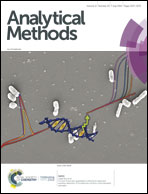Boronate affinity-based surface-imprinted quantum dots as novel fluorescent nanosensors for the rapid and efficient detection of rutin†
Abstract
Novel boronate affinity-based surface-imprinted CdTe quantum dots (BA-CdTe@MIPs QDs) were fabricated to develop a selective and sensitive fluorescent nanosensor for the rapid and efficient detection of rutin. The boronate affinity-based MIP and CdTe quantum dots were used as recognition elements and signal-transduction materials, respectively. The MIPs ensure specificity, while the fluorescence detection provides sensitivity. Under the optimum conditions, the imprinting factor (IF) was evaluated to be 6.51, which implies that a lot of specific binding sites in BA-CdTe@MIPs QDs could be successfully established from the surface imprinting. The obtained BA-CdTe@MIPs QDs exhibited excellent selectivity and high sensitivity for rutin molecules. The relative fluorescence intensity of the BA-CdTe@MIPs QDs decreases linearly with an increasing concentration of rutin in the 0.1–30 μM concentration range, and the detection limit is 0.04 μM. The developed nanosensor was successfully applied to the detection of rutin in fruits, vegetables and medicinal plants. Good recoveries ranging from 94.0 to 101.1% with relative standard deviations (RSDs) below 1.63% were obtained. This study provides a facile and efficient fluorescence tool for rutin detection in real samples. In addition, this method also opens up new avenues for the rapid and efficient determination of cis-diol-containing flavonoids, such as rutin.



 Please wait while we load your content...
Please wait while we load your content...